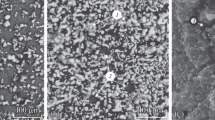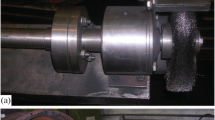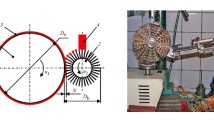Abstract
The results of comparative tests of copper coatings formed by electroplating and deformation cladding with a flexible tool (DGFT) under ultimate loads that cause breakage and burrs have been presented. The number of cycles of lateral bending that cause the copper coating to peel and the sample to break, as well as coefficient of sliding friction and the wear of samples during the friction of a lubricant-free spherical indenter on the flat surface of the copper-plated steel disks with substrate hardnesses of 20, 50, and 70 HRC, have been accepted as the performance standards. During the peeling test under bending, it has been found that cladded coatings were not peeled off from the basic material, even in the case when experimental samples were broken, and the peeling of coating in the samples with galvanic coatings has been observed on half of the first bending cycle. Based on the results of the tribotechnical tests, it has been found that copper coatings formed using the above technologies contribute mainly to a reduction in the coefficient of sliding friction on friction surfaces compared to samples without coatings. However, under loads that cause burrs, galvanic coatings have smaller values of the coefficient of sliding friction compared to cladded coatings.
Similar content being viewed by others
References
Yampol’skii, A.M., Mednenie i nikelirovanie (Copper and Nickel Plating), Leningrad: Mashinostroenie, 1977, 4th ed.
Lobanov, M.L., Kardonina, N.I., Rossina, N.G., and Yurovskikh, A.S., Zashchitnye pokrytiya (Protective Coatings), Yekaterinburg: Ural. Gos. Univ., 2014.
Kolganov, L.A., Svarochnye raboty. Svarka, rezka, paika, naplavka (Welding Works: Welding, Cutting, Soldering, and Surfacing), Moscow: Dashkov i Ko, 2003.
Technological properties of welding wire. http://www.spectechsoyuz.com/.
Trends in the development of welding technology. http://www.weldingsite.com.ua/.
Belevskii, L.S., Plasticheskoe deformiravanie poverkhnostnogo sloya i formirovanie pokrytiya pri nanesenii gibkim instrumentom (Plastic Deformation of Surface Layer and Coating Applied by a Flexible Tool), Magnitogorsk: Litsei Ross. Akad. Nauk, 1996.
Antsupov, V.P., Teoriya i praktika plakirovaniya izdelii gibkim instrumentom (Theory and Practice of Sheathing of Products by Flexible Tool), Magnitogorsk: Magnitogorsk. Gos. Tekh. Univ. im. G.I. Nosova, 1999.
Belevskii, L.S., Ismagilov, R.R., Kadoshnikov, V.I., Belevskaya, I.V., and Yulchubaev, N.B., Improvement of metal products by friction sheathing, Stanochnyi Park, 2011, no. 11, pp. 30–32. http://www.stankopark. spb.ru/.
Sotnikov, A.V., Prevention of scoring on friction surfaces of cast iron parts, Stanki Instrum., 1990, no. 6, pp. 30–31.
Levantsevich, M.A., Maksimchenko, N.N., and Kalach, V.N., Influence of coatings on the antiskip properties of slipping guides, Russ. Eng. Res., 2013, vol. 33, no. 4, pp. 213–216.
Author information
Authors and Affiliations
Corresponding author
About this article
Cite this article
Sheleg, V.K., Levantsevich, M.A., Pilipchuk, E.V. et al. Study of the Performance of Copper Coatings Formed by Electroplating and Deformation Cladding with a Flexible Tool. J. Frict. Wear 39, 6–11 (2018). https://doi.org/10.3103/S1068366618010117
Received:
Published:
Issue Date:
DOI: https://doi.org/10.3103/S1068366618010117




